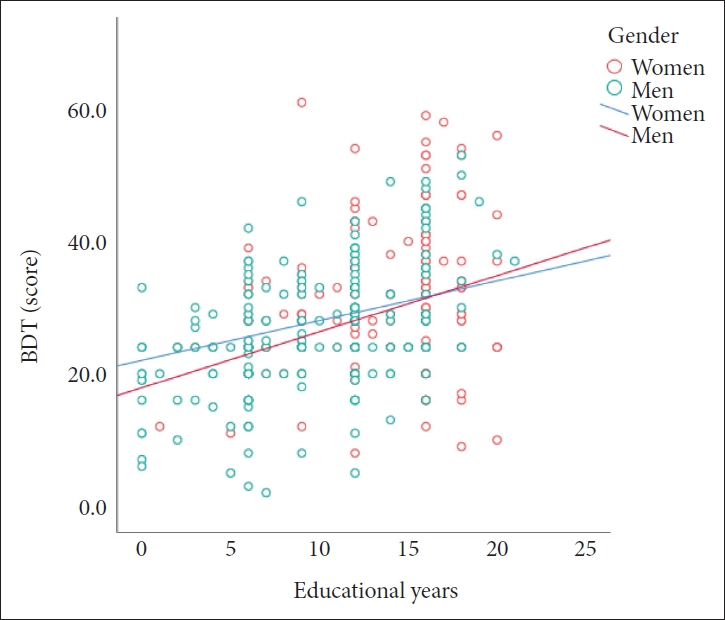1. Wechsler D. WAIS-R Manual: Wechsler Adult Intelligence Scale-revised. New York: Psychological Corporation; 1981.
2. Lazarevi─ć LB, Kne┼Ševi─ć G, Miti─ć M, Jo─Źi─ć DD. Psychometric properties of the Serbian version of the Wechsler adult intelligence Scale-Fourth Edition (WAIS-IV). Psihologija 2018;51:333-349.

3. Kaufman AS, McLean JE, Reynolds CR. Sex, race, residence, region, and education differences on the 11 WAIS-R subtests. J Clin Psychol 1988;44:231-248.


4. Valentine T, Block C, Eversole K, Boxley L, Dawson E. Wechsler Adult Intelligence Scale-IV (WAIS-IV). In: Carducci BJ, editor. The Wiley-Blackwell Encyclopedia of Personality and Individual Differences. Hoboken, NJ: John Wiley & Sons, 2018, p. 457-463.
5. Lezak MD. Neuropsychological Assessment. 3rd Ed. New York, NY, US: Oxford University Press; 1995.
7. Ponton MO, Satz P, Herrera L, Ortiz F, Urrutia CP, Young R, et al. Normative data stratified by age and education for the Neuropsychological Screening Battery for Hispanics (NeSBHIS): Initial report. J Int Neuropsychol Soc 1996;2:96-104.


8. Elias MF, Dore GA, Goodell AL, Davey A, Zilioli MK, Brennan S, et al. Normative data for elderly adults: the Maine-Syracuse study. Exp Aging Res 2011;37:142-178.


9. Elkadi S, Clark MS, Dennerstein L, Guthrie JR, Bowden SC, Henderson VW. Normative visuospatial performance in Australian midlife women. Aust Psychol 2006;41:43-47.

10. Ivnik RJ, Malec JF, Smith GE, Tangalos EG, Petersen RC, Kokmen E, et al. MayoŌĆÖs older americans normative studies: WAIS-R norms for ages 56 to 97. Clin Neuropsychol 1992;6:1-30.

11. Zink DN, Miller JB, Caldwell JZK, Bird C, Banks SJ. The relationship between neuropsychological tests of visuospatial function and lobar cortical thickness. J Clin Exp Neuropsychol 2018;40:518-527.


13. Joy S, Fein D, Kaplan E, Freedman M. Quantifying qualitative features of Block Design performance among healthy older adults. Arch Clin Neuropsychol 2001;16:157-170.


14. Wahlin TBR, Backman L, Wahlin A, Winblad B. Visuospatial functioning and spatial orientation in a community-based sample of healthy very old persons. Arch Gerontol Geriatr 1993;17:165-177.


15. Wang Q, Sun J, Ma X, Wang Y, Yao J, Deng W, et al. Normative data on a battery of neuropsychological tests in the Han Chinese population. J Neuropsychol 2011;5:126-142.


16. R├Čnnlund M, Nilsson LG. Adult life-span patterns in WAIS-R Block Design performance: Cross-sectional versus longitudinal age gradients and relations to demographic factors. Intelligence 2006;34:63-78.

17. Diaz RR, Lynn R. Sex differences on the WAIS-IV in Chile. Mankind Q 2016;57:52-57.

18. Heaton RK, Ryan L, Grant I, Matthews CG. Demographic Influences on Neuropsychological Test Performance. In: Grant I, Adams KM, editor. Neuropsychological Assessment of Neuropsychiatric Disorders. 2nd Edition. New York: Oxford University Press, 1996, p. 141-163.
19. Polunina A, Bryun E, Sydniaeva E, Golukhova E. Gender differences in cognitive functions: retrospective analysis of the data of 5 neuropsychological studies. Sch Rep 2018;3:61-75.
20. de Frias CM, Nilsson LG, Herlitz A. Sex differences in cognition are stable over a 10-year period in adulthood and old age. Neuropsychol Dev Cogn B Aging Neuropsychol Cogn 2006;13:574-587.


21. Parsons TD, Rizzo AR, van der Zaag C, McGee JS, Buckwalter JG. Gender differences and cognition among older adults. Aging Neuropsychol Cogn 2005;12:78-88.

22. Weiss E, Siedentopf CM, Hofer A, Deisenhammer EA, Hoptman MJ, Kremser C, et al. Sex differences in brain activation pattern during a visuospatial cognitive task: a functional magnetic resonance imaging study in healthy volunteers. Neurosci Lett 2003;344:169-172.


23. Lee DY, Lee KU, Lee JH, Kim KW, Jhoo JH, Kim SY, et al. A normative study of the CERAD neuropsychological assessment battery in the Korean elderly. J Int Neuropsychol Soc 2004;10:72-81.


25. American Psychiatric Association. Diagnostic and Statistical Manual of Mental Disorders: DSM-IV-TR. Washington, DC: American Psychiatric Assocation Inc; 2000.
26. Hwang S, Kim J, Park K, Chey J, Hong S. Korean Wechsler Adult Intelligence Test. 4th Ed. Daegu: Korean Psychology; 2011.
27. Pauker JD. Constructing overlapping cell tables to maximize the clinical usefulness of normative test data: rationale and an example from neuropsychology. J Clin Psychol 1988;44:930-933.


29. Thilers PP, Macdonald SW, Herlitz A. The association between endogenous free testosterone and cognitive performance: a population-based study in 35 to 90 year-old men and women. Psychoneuroendocrinology 2006;31:565-576.


30. Sammons P. Gender, Ethnic and Socio-economic Differences in Attainment and Progress: a longitudinal analysis of student achievement over 9 years. Br Educ Res J 1995;21:465-485.

31. Sahadevan S, Tan NJ, Tan T, Tan S. Cognitive testing of elderly Chinese people in Singapore: influence of education and age on normative scores. Age Ageing 1997;26:481-486.


33. Malec JF, Ivnik RJ, Smith GE, Tangalos EG, Petersen RC, Kokmen E, et al. MayoŌĆÖs older americans normative studies: Utility of corrections for age and education for the WAIS-R. Clin Neuropsychol 1992;6(Suppl):31-47.











